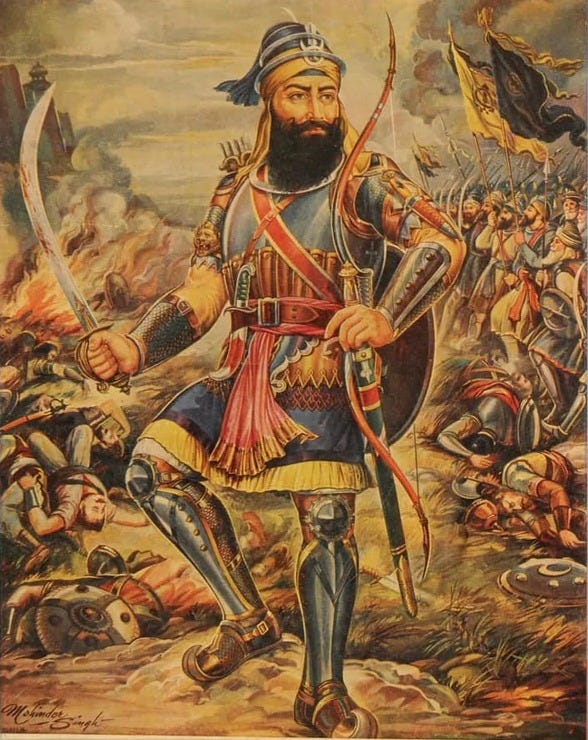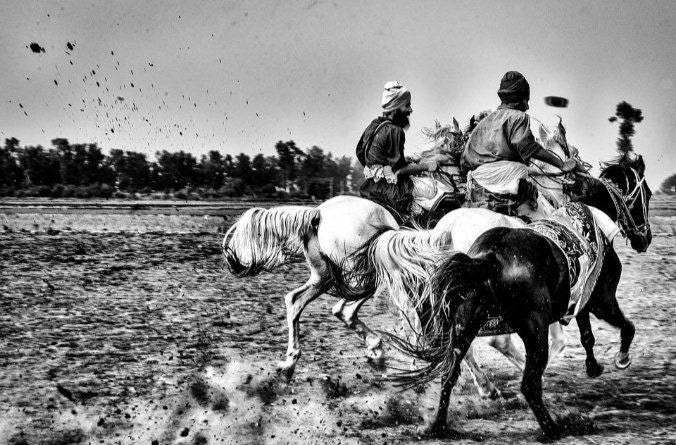Introduction:
The Germans retain a distinct comprehension of the individual’s relationship with society that they define as Bildung. While various schools of thought analyze the cultural implications of this term, the foundational works of philosopher Wilhelm Von Humboldt (c.1767-c.1835) lend it a precise meaning that encompasses both the individual’s deeper process of development by socializing with their external environment and the aptitude-based skills they require for this. Put simply, Von Humboldt proposed that an individual’s inner and outer transformation are interrelated and by mitigating the role of one the other is wasted. While a growing number of philosophers such as Lene Rachel Andersen, Tomas Bjorkman, Jonathan Rowson, and Zachary Stein are currently attempting to map a blueprint for the implementation of Bildung, its prototype in the Sikh praxis unfortunately remains unstudied.
The World:
Man is a creature of the world possessing a distinct identity in the worldly paradigm. Though several philosophies such as Buddhism and Sanataanism emphasize renunciation of both self and society to evade tribulations, such a cowardly avoidance of life’s difficulties renders them inconsequential insofar as their ability to assert and implement their unique religiopolitical dynamic for a prolonged period. It then falls on other more radically assertive belief systems to furnish a means of fashioning both a perfect spiritualist and a leader that can lead society as both a saint and warrior for its own good. This correlation of a purposeful human development, for the greater good of the society in which it establishes itself, is something that is keenly being recognized by the current crop of philosophers and self-help experts hoping to steer humanity away from the mental and psychological stagnation its finds itself mired in today.

Starting Point:
How does one imbibe the desire for Bildung? It is intriguing to note that outside the religious paradigm, it was the Italian humanist Marsilio Ficino (c.1433-c.1499) who was the first to advise readers in his Three Books On Life (circa 1489) that the path to truly transforming one’s own inner self and then their external environment lay not in attempting to emulate great heroes of the past, but rather in knowing oneself. The maxim of know thyself became his rallying cry and inspired Sigmund Freud (c.1856-c.1939) who would transform it into a cornerstone of his psychoanalytical ventures. But both Ficino and Freud failed in mapping a path to knowing oneself. How could one realize the self if one was to treat it as an alien aspect of their own being but worthy only of cold, unfeeling dissection? The failure of both men to discern the inability of science to proceed behind the observatory stage resulted in the rise of Jungian analysis.
The Archetype:
For Carl Jung (c.1875-c.1961), anything of this world had to be studied in relation to this world and could not be divorced from either itself or its environment as both ascetic religiosity and Freudian analysis was wont to do. He rationalized the existence of an individual unconsciousness superimposed on a transpersonal or more universal unconsciousness that archives humanity’s latent memories from both its ancestral and evolutionary pasts, delineating that this latency was visible in common mythological archetypes that while forming the distinct backbone of individual cultures and traditions was also evident among humans universally irrespective of affiliation and location. Jung proposed the existence of twelve archetypes that could furnish greater consistency in knowing one’s own self. These were: the ruler, the sage, the trickster, the explorer, the rebel, the hero, the magician, the everyman, the innocent, the caregiver, and the lover.
The Hero:
The mythologist Joseph Campbell (c.1909-c.1987) in his seminal work The Hero With A Thousand Faces (circa 1949) would propose that out of the twelve Jungian archetypes, the hero was the most crucial as the necessity of self-knowledge was a prerequisite for them prior to beginning their quest. Subsequently, as their quest progressed, they would find copious inner strength arising from within themselves to challenge their foes and overcome their trials. Campbell identified not only mythological examples of this principle but also historical examples substantiating that if anything then the hero was the true upholder of Bildung because the hero adventured out not for himself but for his society. The journey of the hero originated from weakness, the atrophying of their environment, the near-demise of their society compelling them to grow as individuals while battling the unknown and then returning to banish the past and usher in glory.
The Anti-Hero:
Campbell would argue in another work, The Power Of Myth (circa 1988), that the hero’s quest represented another more nuanced aspect of the individual’s journey. Transitioning from a stagnant condition to a richer, more mature, condition. From a Jungian perspective, Campbell concluded, that the hero’s battle with monsters and the unknown represented a battle within their own human self to subdue their more bestial desires and slay their inner beast. Liberated thus, the hero would then return to selflessly rebuild his society or world imbibing all the remaining Jungian archetypes. But the very fact that the hero would venture out to undergo the most severe of trials for their own kith and kin proved not only their altruism but their worthiness to lead others and furnish more heroes. Thus the original hero would tread a sharp path and subdue their own anti-hero to emerge as a stronger hero and then complete their quest to create even more heroes.

The Sikh Perspective:
There are certain parallels between the Sikh praxis and the Jungian perspective. It should be noted that although Sikhi predates Jung, it is the misfortune of the Sikhs that the white bearded thugs leading them are unable to construct any viable intellectual tradition through which to communicate the faith’s nuances to the world at large. The subjugation of the inner beast on the path to perfection is identified as being crucial for the Sikh,
ਨਰੂ ਮਰੈ ਨਰੁ ਕਾਮਿ ਨ ਆਵੈ ॥ ਪਸੂ ਮਰੈ ਦਸ ਕਾਜ ਸਵਾਰੈ ॥੧॥
ਅਪਨੇ ਕਰਮ ਕੀ ਗਤਿ ਮੈ ਕਿਆ ਜਾਨਉ ॥ ਮੈ ਕਿਆ ਜਾਨਉ ਬਾਬਾ ਰੇ ॥੧॥ ਰਹਾਉ ॥
ਹਾਡ ਜਲੇ ਜੈਸੇ ਲਕਰੀ ਕਾ ਤੂਲਾ ॥ ਕੇਸ ਜਲੇ ਜੈਸੇ ਘਾਸ ਕਾ ਪੂਲਾ ॥੨॥
ਕਹੁ ਕਬੀਰ ਤਬ ਹੀ ਨਰੁ ਜਾਗੈ ॥ ਜਮ ਕਾ ਡੰਡੁ ਮੂੰਡ ਮਹਿ ਲਾਗੈ ॥੩॥੨॥
“What do I know of my acts? What do I learn from their consequences? When the human within (conscience) perishes then an individual becomes obsolete. However, if the beast within perishes than the individual is useful for ten purposes and more. In the end, all our bones will perish like logs in flame. Our hairs will wither away like hay in wind. Kabir askes the reader, will you only awaken then when death knocks at your door?”
-Guru Granth, 870.
The subjugation of the inner bestial self is cast as the highest endeavor that once mastered can furnish almost superhuman resilience in one’s quest to live life perfectly. Then, even the great unknown (death) cannot frighten one in the pursuit of their aims.
ਗਗਨ ਦਮਾਮਾ ਬਾਜਿਓ ਪਰਿਓ ਨੀਸਾਨੈ ਘਾਉ ॥
ਖੇਤੁ ਜੁ ਮਾਂਡਿਓ ਸੂਰਮਾ ਅਬ ਜੂਝਨ ਕੋ ਦਾਉ ॥੧॥
ਸੂਰਾ ਸੋ ਪਹਿਚਾਨੀਐ ਜੁ ਲਰੈ ਦੀਨ ਕੇ ਹੇਤ ॥
ਪੁਰਜਾ ਪੁਰਜਾ ਕਟਿ ਮਰੈ ਕਬਹੂ ਨ ਛਾਡੈ ਖੇਤੁ ॥੨॥੨॥
“The battle drums reverberate and wounds bleed open. The warriors lusting for the battlefield now receive the opportunity to join battle. Acknowledge only those as warriors who war for their principles. They may be hacked from limb to limb and even more but they will still not relinquish the field of battle.”
-Guru Granth, 1105.
The path to perfection is similar in the sense that the hero ventures out for the sake of their community and not any other. This sense of altruism amalgamated with loyalty is a foundational element of Sikhi where the Sikh serves the Sikh first for they are on the true path of the Guru. All non-Sikhs are prioritized after a Sikh because their false beliefs are usually caustic to the Panth at large. But the Sikh hero is not one who exclusively learns about the self while on their mission. The emphasis is on prior self-mastery by restraining the vices of lust, obsession, wrath, hubris, and fear.
ਮੰਤ੍ਰੰ ਰਾਮ ਰਾਮ ਨਾਮੰ ਧ੍ਯ੍ਯਾਨੰ ਸਰਬਤ੍ਰ ਪੂਰਨਹ ॥
ਗ੍ਯ੍ਯਾਨੰ ਸਮ ਦੁਖ ਸੁਖੰ ਜੁਗਤਿ ਨਿਰਮਲ ਨਿਰਵੈਰਣਹ ॥
ਦਯਾਲੰ ਸਰਬਤ੍ਰ ਜੀਆ ਪੰਚ ਦੋਖ ਬਿਵਰਜਿਤਹ ॥
ਭੋਜਨੰ ਗੋਪਾਲ ਕੀਰਤਨੰ ਅਲਪ ਮਾਯਾ ਜਲ ਕਮਲ ਰਹਤਹ ॥
ਉਪਦੇਸੰ ਸਮ ਮਿਤ੍ਰ ਸਤ੍ਰਹ ਭਗਵੰਤ ਭਗਤਿ ਭਾਵਨੀ ॥
ਪਰ ਨਿੰਦਾ ਨਹ ਸ੍ਰੋਤਿ ਸ੍ਰਵਣੰ ਆਪੁ ਪ਼ਤ੍ਯ੍ਯਾਗਿ ਸਗਲ ਰੇਣੁਕਹ ॥
ਖਟ ਲਖ੍ਯ੍ਯਣ ਪੂਰਨੰ ਪੁਰਖਹ ਨਾਨਕ ਨਾਮ ਸਾਧ ਸ੍ਵਜਨਹ ॥੪੦॥
“To forever remember the all pervasive Creator and focus on the Creator’s virtues. Those who live by such wisdom are untouched by both pain and pleasure, living blamelessly and fearlessly. They are imbued with pity for all creatures and subdue the five thugs within themselves. They sing the praises of their Creator, remain unsullied by illusion, and are like lotus on water. They treat friend and foe impartially and are attached only to the Maker’s path. They renounce their arrogance, refrain from undue speech, and are humble. Whosoever possesses such qualities, only they can be considered true loyalists.”
-Guru Granth, 1357.
This injunction is indicative of the Khalsa mentality that is designed to identify the most able, and strongest among the Sikhs to lead them in their quest for dominance and rebuilding the world in their own image. Such a sensitive mission can ill-afford a hero grappling with themselves on their quest heightening the risk of failure.
The Guru Archetype:
A crucial foundation of Sikhi is the importance of the Guru archetype. This is from where the Sikh hero archetype and all other archetypes flow. The foremost Sikh theologian Bhai Gurdas (c.1551-c.1636) elaborates upon the nature of the Guru archetype:
ਸਿਧ ਸਾਧਿਕ ਮਿਲਿ ਜਾਗਦੇ ਕਰਿ ਸਿਵਰਾਤੀ ਜਾਤੀ ਮੇਲਾ।
The Sidhs and other recluses meet and attempt to awaken themselves by performing austerities at the Sivratri fair.
ਮਹਾਦੇਉ ਅਉਧੂਤੁ ਹੈ ਕਵਲਾਸਣਿ ਆਸਣਿ ਰਸਕੇਲਾ।
Mahadev is a recluse and is infatuated with Yogic poses, thinking they will awaken him.
ਗੋਰਖੁ ਜੋਗੀ ਜਾਗਦਾ ਗੁਰਿ ਮਾਛਿੰਦ੍ਰ ਧਰੀ ਸੁ ਧਰੇਲਾ।
The ascetic Gorakh calls himself awake after meeting his Guru Machindar, the lustful one who eloped with a concubine.
ਸਤਿਗੁਰੁ ਜਾਗਿ ਜਗਾਇਦਾ ਸਾਧਸੰਗਤਿ ਮਿਲਿ ਅੰਮ੍ਰਿਤ ਵੇਲਾ।
But only Satguru (Guru Nanak) is the true awakener who meets the Sadhsangat at the ambrosial hours.
ਨਿਜ ਘਰਿ ਤਾੜੀ ਲਾਈਅਨੁ ਅਨਹਦ ਸਬਦ ਪਿਰਮ ਰਸਖੇਲਾ।
In the divine house (Gurudwara), deep contemplation is practiced and the self enjoys immersion within the wisdom of the unspoken speech.
ਆਦਿ ਪੁਰਖ ਆਦੇਸ ਹੈ ਅਲਖ ਨਿਰੰਜਨ ਨੇਹੁ ਨ ਵੇਲਾ
The primal Being is deserving of all salutations for he is unmarked and forever existent.
ਚੇਲੇ ਤੇ ਗੁਰੁ ਗੁਰੁ ਤੇ ਚੇਲਾ ॥੧੭॥
And so from the disciple to the Guru and from Guru to the disciple.
-17:26
The final line is noteworthy for it evidences that the Gurus, from Guru Nanak the progenitor Guru onwards, subjected themselves to mortal constraints and underwent the same limitations as mortals to prove that the rigorous path of Sikhi as exemplified by the Khalsa was doable. It is this descent of true divinity from the divine realms to the world of mortals, in the form of the Gurus, and its undergoing of the same tribulations as the common man that sanctifies the path of Sikhi as the only true faith in a world of false faiths. The Guru archetype underwent the same rigors as the Sikh (disciple) and from their was established the continuity of a Sikh ascending to Guruship until the investiture of the Panth as Guru in 1698. The Gurus tread the path of the unknown, the Khalsa, to inspire their Sikhs to follow them by limiting themselves to mortal faculties in order to show the distinctive ability of mere man to become mortals with divine benediction.

Conclusion:
Bildung argues for the interrelated development of the individual and their society by arguing that the development of the human results in more effective societal development. The path to this is rooted in self-knowledge but how to obtain this self-knowledge is subject to heavy debate. For Freud, it was acquirable by cold mental dissection with surgical precision. For Jung, it was attainable by studying the universal unconscious and its archetypes. But within Sikhi, self-knowledge as a means of Bildung cannot be achieved by academic wrangling or self hypnosis. It has to be done practically and through constant self-refinement or Naam. In this respect, the Sikh hero exemplifies Joseph Campbell’s perennial state of warfare against both the unknown within and the unknown without. The Sikh Gurus furnished a pragmatic blueprint for self-knowledge and then societal betterment. It is a shame the Sikhs are not able to promote its advantages further.






This is great- good content. Any idea if there will be any more english language podcasts?